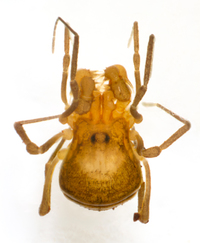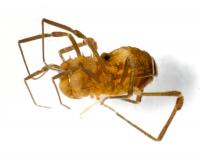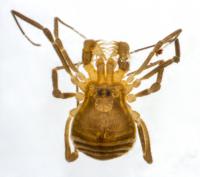Distribution Records
PDF
Vetting Levels |
|
Adult phenology:
High Mountains (HM) ≥ 4,000 ft.
Low Mountains (LM) < 4,000 ft.
Piedmont (Pd)
Coastal Plain (CP)
Click on graph to enlarge
|
 |
|
| synonym | |
| taxonomic_comments |
One of two species in this genus, both of which occur in the East (Kury, 2003) but with only brunneus recorded in North Carolina. Placed in the Travnuiidae by Kury (2002), which includes Erebomaster but not Bishopella, which is retained within the Phalangodidae. |
| species_comment |
The type locality for this species is the "valley of the Black Mountains" in Yancey County, where W. Beutenmuller made several collecting trips in the late 1800s. This species was described by N. Banks (1902) -- who joined Beuntemuller on one of these trips -- as Scotolemon brunnea. |
| id_comments |
A minute, yellowish-brown Armored Harvestman. The coloration of the body ranges from yellowish-brown to dark brown (Banks, 1902; Briggs, 1969). The eyes are rimmed with black and the area posterior to the ocular tubercle can be heavily mottled (Briggs, 1969). |
| total_length |
2.34 mm, males (Briggs, 1969) |
| structural_features |
The scute of the abdomen is smooth, without obvious sutures; this contrasts with Erebomaster acanthinus, where the scute is divided (Briggs, 1969). Tarsus of the palps has three prominent pairs of spines. The legs are scabrous and the rear margin of the abdominal tergites are tuberculate. The chelicerae in the males have two forward projecting tubercles; those of the females are smooth. |
| silk_web |
|
| fld_guide_descriptions |
|
| online_photos |
BugGuide |
| prey |
|
| predators |
|
| behavior |
|
| distribution_reference |
Banks (1902) |
| technical_reference |
Briggs (1969) |
| adult_id | 1 identifiable by photo 2 identifiable by photo of specific features and/or supplementary info 3 identifiable from specimen only |
| abundance |
|
| distribution_comments |
This species appears to be restricted to the mountains, where it has been especially widely collected, considering its dwelling deep in the leaf litter |
checklist_mt_high
>=4,000 ft. | |
checklist_mt_low
<4,000 ft. | |
checklist_pd
Piedmont | |
checklist_cp
Coastal Plain | |
| habitat |
Deep, wet leaf litter, including that under Rhododendrons. Records come from over 6000' at Grandfather Mountain down to below 2000' at Bat Cave. |
| observation_methods |
Best found by sifting leaf litter or through use of Berlese funnels |
| state_protection |
Arachnids are not protected under state law, although permits are needed to collect them in State Parks and other public and private nature preserves |
| NHP_ranks |
[GNR] [S3S4] |
| NHP_status |
|
| status_comments |
This is one of the most frequently collected of our montane, cryophilic harvestmen and has a fairly extensive range in the North Carolina mountains. Nonetheless, its habitat specializations probably make it vulnerable to the dessicating impacts associated with clear-cutting and it may be susceptible to both the heating and drying effects of global climate change. While populations currently appear to be fairly numerous and widespread, this species along with the other cryophilic biota of the mountains should be monitored for downward changes. |
Photo Gallery for Theromaster brunneus No common name |
 | Recorded by: Carol Tingley
Avery Co.
Comment: leaf litter |  | Recorded by: Carol Tingley
Avery Co.
Comment: leaf litter |
 | Recorded by: Carol Tingley
Watauga Co.
Comment: 1 male, 1 female. Sifted from mixture of litter, soil, and moss |  | Recorded by: Carol Tingley
Watauga Co.
Comment: 1 male, 1 female. Sifted from mixture of litter, soil, and moss |
 | Recorded by: Carol Tingley
Watauga Co.
Comment: 1 male, 1 female. Sifted from mixture of litter, soil, and moss |  | Recorded by: Carol Tingley
Avery Co.
Comment: Collected in Rhododendron leaf litter |
|